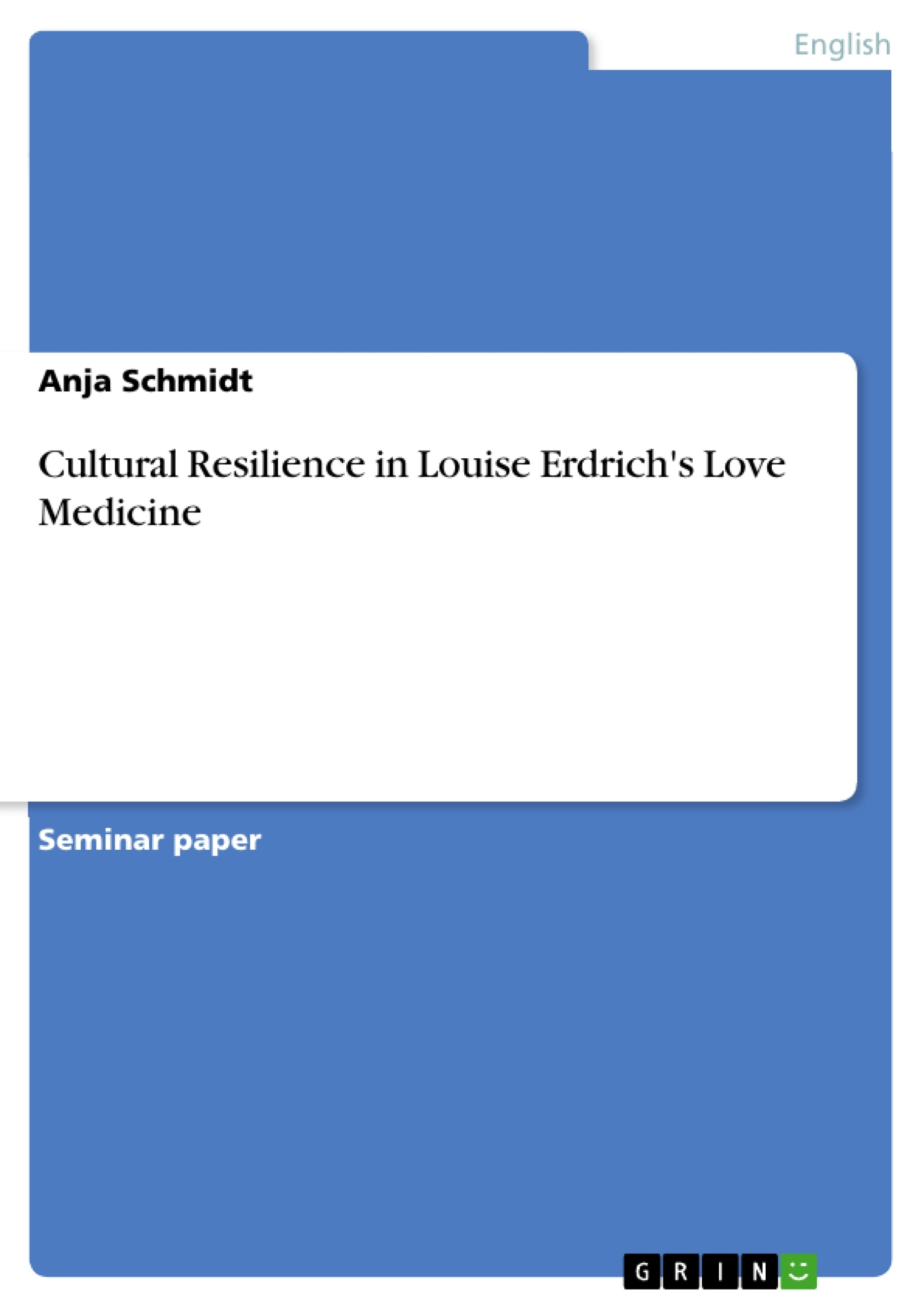Set on a North Dakota reservation, Louise Erdrich’s novel Love Medicine1 is first of all a
fictitious story. Despite a writer’s Indian heritage2 it is unsound to read novels as a “true
accounts” of reservation life, yet it seems to me that Erdrich’s depiction of Chippewa families
includes some issues that are very much part of American Indian reality.
“Federal and private agencies have made a series of depressing reports as to the condition of
American Indian youth, both in the home and in their interaction with the judicial system.”3
Sentences like this one are ubiquitous in sources not only on young American Indians.
The problems usually mentioned are: Foetal Alcohol Syndrome, alcohol abuse, domestic
violence, gang violence, rape, unemployment, jobs with little chance of career growth,
depression, suicide and teen pregnancy.4
A number of explanations have been found. “Historical trauma response (HTR) theory is
based on the hypothesis that when people were victims of cultural trauma, the aftereffects can
be passed down through the generations.”5 Variants of this are Transgenerational Post
Traumatic Stress Disorder or “soul wound.“6
Another popular theory is that of “internalized oppression.”
This theory states that Natives have been oppressed for hundreds of years and as a group have taken
into their own psyche the characteristics of the oppressors resulting in the tendency to oppress
themselves even in the absence of an identifiable external oppressor.7
== ==
1 Erdrich, Louise. Love Medicine. Hammersmith: Harper Perennial, 2004.
2 Louise Erdrich’s mother is Ojibwe.
3 Fuller, Gary. “A Snapshot Report on American Indian Youth and Families”, in:
http://www.ocbtracker.com/0007/snapshot.html. (taken Feb. 9th 2005).
4 Ibid.
5 Strand, Joyce; Peacock, Robert (eds.). “Resource Guide: Cultural Resilience”, in: Tribal College Journal
http:/www.tribalcollegejournal.org/themag/backissues/summer2003/summer2003resource.html. (taken Feb. 2nd
2005)
6Kindya, Kenneth. “Native mental health: Issues and challenges”, in:
http://www.indiancountry.com/content.cfm?id=1063901101 (taken Feb. 2nd 2005).
7 Ibid.
This sounds like a variation of Stanley Elkins’ notorious “Sambo-thesis” widely repudiated by the Civil Rights
Movement because it negates African Americans’ agency.
Table of Contents
- Introduction
- Methodological Remarks
- 1. Moses
- 2. Marie
Objectives and Key Themes
This analysis of Louise Erdrich's novel "Love Medicine" aims to explore how the theme of resilience in the face of historical trauma and cultural oppression is portrayed through the experiences of the characters. The novel's setting on a North Dakota reservation offers a unique perspective on the complexities of Native American identity and the challenges faced by Indigenous communities.
- Cultural Resilience
- Historical Trauma and Its Impact on Indigenous Communities
- Native American Identity Formation
- Internalized Oppression and its Effects on Individuals and Communities
- The Role of Traditional Beliefs and Practices in Healing and Resistance
Chapter Summaries
The introduction sets the stage for the analysis, focusing on the prevalence of issues such as alcoholism, violence, and poverty within Native American communities. The text then examines two prevalent theories: "historical trauma response" and "internalized oppression" to explain these issues.
The methodological remarks clarify the approach to the analysis, emphasizing the focus on a close reading of "Love Medicine" and avoiding generalizations about Chippewa culture. The text highlights the novel's non-chronological structure and multi-narrator approach, indicating the specific characters that will be analyzed.
The first chapter examines the character of Moses, who experiences illness and isolation, drawing on traditional beliefs to survive. His reliance on the old ways, however, creates a sense of confinement.
The second chapter focuses on Marie, who struggles with her Native American identity and seeks acceptance in the Catholic church. She eventually rejects religious authority and embraces her own culture, but continues to grapple with the internalized racism she has absorbed.
Keywords
Key themes explored in "Love Medicine" include cultural resilience, historical trauma, Native American identity, internalized oppression, traditional beliefs and practices, and the consequences of colonialism. The analysis also considers how these themes are manifested in the experiences of the characters, such as Moses, Marie, and other individuals within the novel.
- Quote paper
- Anja Schmidt (Author), 2005, Cultural Resilience in Louise Erdrich's Love Medicine, Munich, GRIN Verlag, https://www.hausarbeiten.de/document/147391


